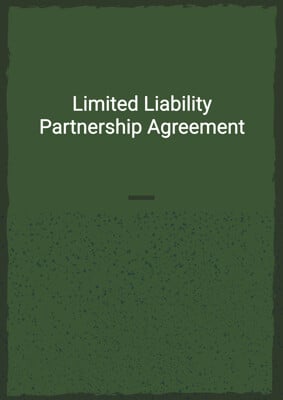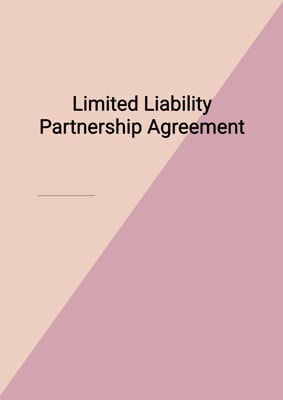How to Tailor the Document for Your Need?
01
Create Document
Fill in the details of the parties. You can click the "Fill with Member’s Information" button to complete it with information saved to your account.
02
Fill Information
Please fill in any additional information by following the step-by-step guide on the left hand side of the preview document and click the "Next" button.
03
Get Document
When you are done, click the "Get Document" button and you can download the document in Word or PDF format.
04
Review Document
Please get all parties to review the document carefully and make any final modifications to ensure that the details are correct before signing the document.
Document Preview
Document Description
A Partnership Agreement is a legal document that outlines the terms and conditions governing the relationship between individuals or entities engaged in a business partnership. It serves as a crucial blueprint for the partnership, clearly defining the rights, responsibilities, and expectations of each partner. This agreement is commonly used to establish a framework that promotes transparency, minimizes disputes, and safeguards the interests of all parties involved.
As per the Uniform Partnership Act , Partnership is defined as 'an association of two (2) or more persons to carry on as co-owners a business for profit and includes for all purposes of the laws of this state a limited liability partnership.'
In essence, a partnership agreement functions as a comprehensive guide that covers various aspects of the business relationship. It typically addresses key elements such as the distribution of profits and losses, decision-making processes, capital contributions, and the roles and responsibilities of each partner. By explicitly detailing these factors, the agreement helps prevent misunderstandings and potential conflicts, providing a solid foundation for the partnership to thrive.
Partnership Agreement Template is commonly used for
(a) businesses ranging from small enterprises
(b) family business
(c) real estate partnership
(d) Professional services partnerships, such as law firms, accounting firms, or medical practices.
(e) Creative collaborations, like partnerships between artists, writers, or musicians
(f) Educational partnerships between institutions for joint research or programs.
The Partnership Agreement is a legally binding document that establishes a partnership between Party 1, Party 2, and Party 3. The agreement outlines the purpose of the partnership, the management structure, and the rights and obligations of each partner. It also includes provisions for the allocation of profits and losses, the contribution of capital, and the termination of the partnership.
The agreement begins with an interpretation section that defines key terms used throughout the document. It clarifies that the partnership will be conducted in the best interests of the partners and outlines the responsibilities of the partnership board and the executive management team.
The agreement also includes provisions for the partnership's capital, further finance, and the allocation of profits and losses. Each partner is required to make an initial contribution to the partnership's capital, and they are obligated to contribute additional funding as required by the partnership board. Profits and losses are allocated to the partners in proportion to their percentage shares.
The partnership board is responsible for the overall supervision of the business and has the authority to act on behalf of the partnership. It is composed of directors appointed by each partner. The partnership board meets quarterly and is responsible for approving the business plan and budget, making decisions on behalf of the partnership, and resolving any deadlock situations.
The agreement also includes provisions for the transfer of partnership interests, confidentiality, termination, and dispute resolution. It specifies that any transfer of partnership interests must be approved by the other partner and outlines the process for terminating the partnership if a fundamental deadlock or difference arises between the partners.
Overall, the Partnership Agreement is a comprehensive document that establishes the rights and responsibilities of each partner in the partnership and provides a framework for the operation and management of the business.
How to use this document?
To use the Partnership Agreement, follow these steps:
1. Review the entire agreement to familiarize yourself with its contents and understand the rights and obligations of each partner.
2. Ensure that all parties involved in the partnership have a clear understanding of the agreement and agree to its terms.
3. Enter the names and addresses of each partner in the agreement, as well as the name of the partnership.
4. Specify the initial contributions to the partnership's capital for each partner.
5. Determine the percentage shares of each partner based on their capital contributions.
6. Discuss and agree on the funding requirements for the partnership, including any additional funding that may be required in the future.
7. Establish a process for the allocation of profits and losses among the partners.
8. Appoint directors to the partnership board, ensuring representation from each partner.
9. Schedule regular partnership board meetings to discuss and make decisions on behalf of the partnership.
10. Develop a business plan and budget for each accounting period, ensuring that it aligns with the best interests of the partnership.
11. Keep accurate accounting records and prepare audited accounts for each accounting period.
12. Consult with the other partners on matters that materially affect the development of the business and consider any proposals made by them.
13. Maintain confidentiality of all commercial and technical information related to the partnership and its partners.
14. Seek amicable resolution of any disputes or disagreements that may arise between the partners.
15. Comply with all applicable laws and regulations governing the partnership and its activities.
By following these steps, you can effectively use the Partnership Agreement to establish and manage a successful partnership.
There are different types of partnerships and the agreements vary depending on the type i.e. General Partnerhsip, Limited Partnership and Limited Liability Partnership. Read more to understand the differences in the types of Partnerships
Download DocPro's ultimate guide to Partnership, Limited Partnership and LLP Agreements
Not the right document?
Don’t worry, we have thousands of documents for you to choose from:






















































